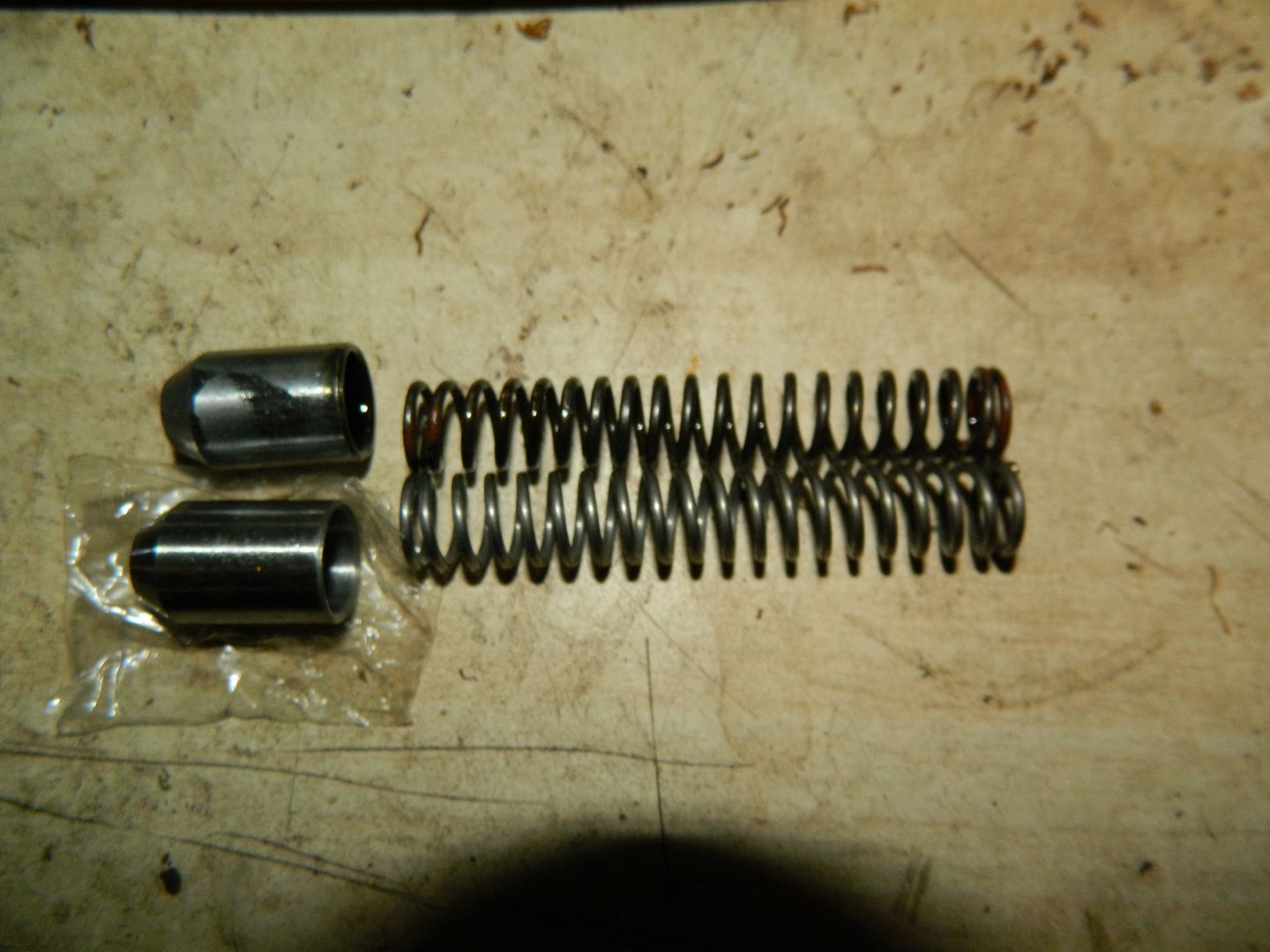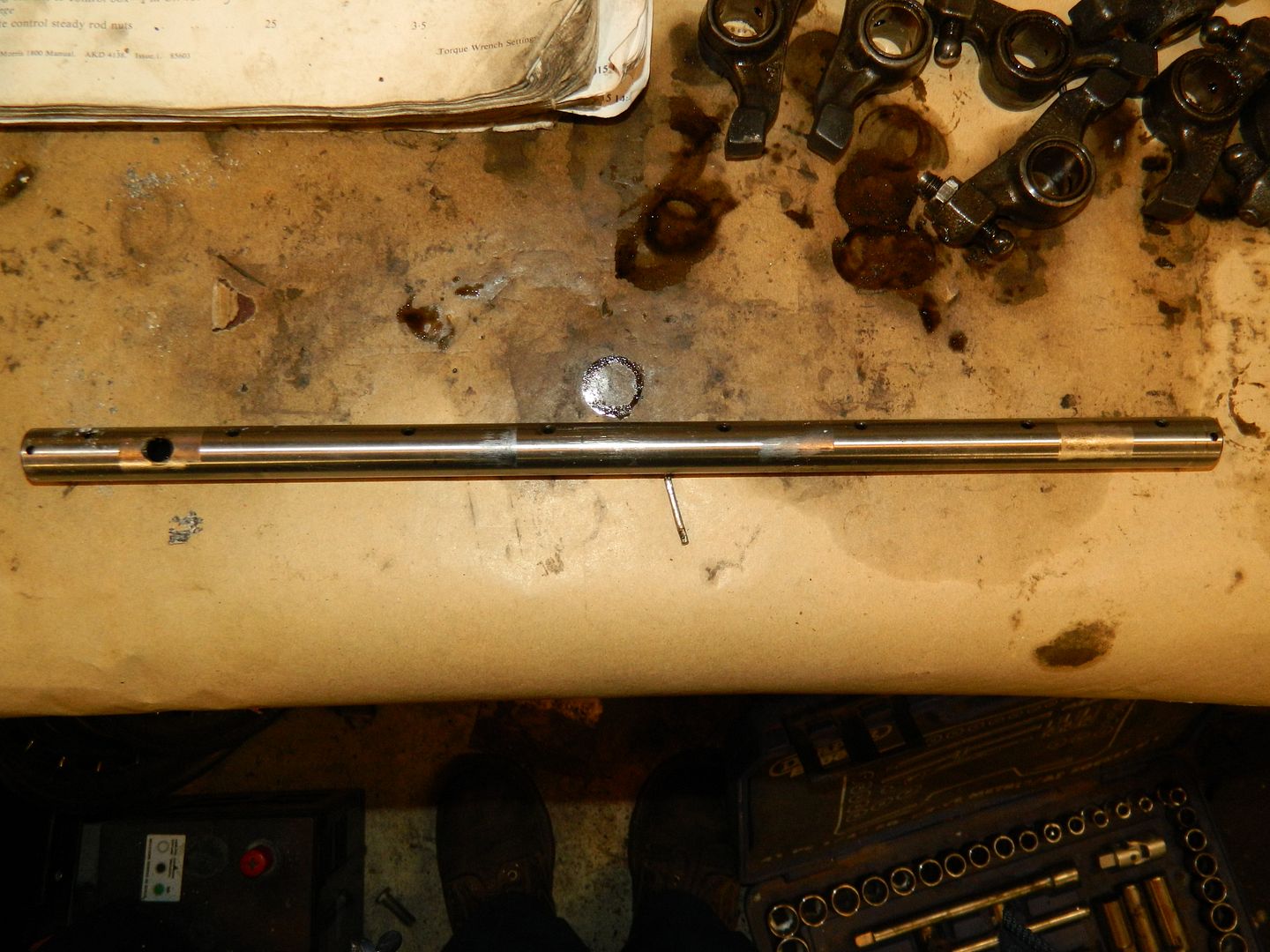|
|
Post by Penguin45 on Sept 28, 2015 19:36:03 GMT
Cleaned off the face of the head and the block and spent some time with a steel rule and wafer thin feeler gauges. I would say that both surfaces are completely flat. Oil pressure relief valve replaced.  New spring and plunger at the bottom. It's about 1.5mm longer and wound the opposite way to the one I've removed. Can't see any significance to that. I think I had to push the cap down a little harder to overcome the spring, so probably just a "good thing" to have done. 8 new stem seals have been fitted of the "top hat" variety. Valves have been cleaned of deposits on the face and above on the stem side. Pillar drill and emery cloth made this pretty straightforward. Not bad for an hour or two of work. Still pondering the way the clutch has worn. Offering up a new carbon release bearing onto the diaphragm shows that it overhangs the edges of the triangle. Also, the wear on the the face of the triangle suggests that the carbon has worn into the steel, looking at the step. That doesn't really make much sense to my mind. Sharp edge to the steel, perhaps? Surely it would disappear as the steel wore away. And, if the carbon shattered, why hasn't the cast iron of the release bearing housing worn on the steel face? Methinks I worry too much. Chris. |
|
|
|
Post by dave1800 on Sept 29, 2015 1:09:49 GMT
Good news about the head /block. Maybe the reason you didn't notice the effect of the blowing between the cylinders is that you have been driving the 3 cylinder Matiz  Not sure about your crb it may be worth contacting Ken L (cptkennykidna) who has done a lot of work on the clutches and crbs and has submitted photos not disimilar to yours, or Tony C (crabmaster) who prepared detailed clutch analysis in his web newsletter publications. I never like putting anything back together without understanding what has gone wrong especially when it involves so much work. I also believe Tony Wood has extensive knowledge of crb failures and may be able to help. David |
|
|
|
Post by Penguin45 on Sept 29, 2015 23:16:38 GMT
Ady is back from holiday next week, so the release bearing will be dealt with then. LOCI club night tonight. Showed Mike Jordan the release bearing from my car; he reckoned that one of the clips had come off, casuing it to run cock-eyed. Seems a pretty reasonable explanation to me.
The engine mountings on the cross member appear to be from a Series 2 Land Rover, so a new pair has been ordered. I also found a source of polyurethene exhaust bobbins, so the mounting can be rebuilt when these arrive.
Chris.
|
|
crabmaster
Member
 
Posts: 44
Attribute: http://www.austineighteenhundred.com.au
|
Post by crabmaster on Sept 30, 2015 7:02:29 GMT
There are two types of release bearings and three types of clutch covers. The new strapless cover, 13H3534, uses the old release bearing (chamfered bore) 13H3176. But then there was a new, new, cover 13H3888 which uses a new bearing 13H3889 (flat face, no chamfer). The first type of strapless cover 13H3888 has stepped taper on the cover thrust place, and by the look of your photo, this is what you have Chris. The new, new cover has a smooth taper on the outside of the thrust plate (which is thinner in cross section) and has to be used with the 13H3889 bearing. According to our Australian service bulletins, the part numbers are:
13H3534 (B&B 75615/11) 13H3176 (B&B 75598), and 13H3888 (B&B76082/11) 13H3889 (B&B76080).
Failure of the bearing is most likely due to over-stroking due to clutch pedal travel - puts excessive pressure on everything (including crankshaft thrust washers). Service Bulletins go on at length about measuring the stroke, and eventually (here, anyway) a new clutch pedal with reduced leverage was introduced. Main trouble is that the clutch travel depends a lot on the thickness of carpet under ones foot and is not precisely controlled, nor can it be easily adjusted.
Tony
|
|
|
|
Post by Penguin45 on Sept 30, 2015 23:04:37 GMT
Thank you Tony, that's excellent information. I was aware of the different clutch covers and had assumed that they simply interchanged. I hadn't realised that there were different release bearings. That said, the clutch that went into the Wolseley Gold Seal engine was a three part kit, so I would think that they were (or should have been) a matched set.
Ady and I have come up with what should be a MkIII bearing - details will follow fairly soon.
Chris.
|
|
|
|
Post by dave1800 on Oct 3, 2015 2:15:26 GMT
I'm intrigued. Could that be the reason you've been asking for old crbs I wonder.  David Ady and I have come up with what should be a MkIII bearing - details will follow fairly soon. Chris. |
|
|
|
Post by Penguin45 on Oct 3, 2015 10:16:05 GMT
Certainly is.  Extensive advertising including here and in the LOCI magazine has yielded........... one. That said, Tony is looking some out for me. I'll publish some details when we've got the prototype done. Chris. |
|
|
|
Post by Penguin45 on Oct 4, 2015 22:54:29 GMT
Not a lot achieved today, due to an outbreak of kitchen cabinet building. Always fun trying to assemble one around the existing pipework under the sink. The new engine mounts for the cross bar have turned up, so that has been loosely assembled ready to fit and that, I'm afraid, is about it.
Chris.
|
|
|
|
Post by Penguin45 on Oct 12, 2015 23:28:09 GMT
Things are stuttering along slowly. The head is now back on the engine. It has new rockers and rocker shaft. An afternoon's scraping produced a couple of clean facing surfaces and piston tops, so on with the Payen head gasket (Damn the expense!) and all now torqued down in three stages. Fingers crossed. A Payen gasket conversion set is heading across from New Zealand (!) (Thanks Indy.) as I really don't want anymore major oil leaks.
It's gently heading the right way. Really ought to go and have a poke round the engine bay - just in case.
Chris.
|
|
|
|
Post by Penguin45 on Oct 13, 2015 17:22:45 GMT
Rocker shaft:   Quite worn - you can see the marks quite clearly. Mores to the point, you can feel them with you finger nail, so the surface is damaged. Replacement from Moss was about £12. Chris. |
|
|
|
Post by tommydp on Oct 13, 2015 20:40:25 GMT
Hm, quite well worn.. A bit strange after such a low mileage. This was the "new" Gold seal engine, right?
Perhaps, the oil supply has been restricted in a way?
Tommy
|
|
|
|
Post by Penguin45 on Oct 13, 2015 23:07:41 GMT
I don't know, Tommy. I have commented on the very low oil pressure at idle earlier. Thing is, I don't know what a Gold Seal engine is. "Factory rebuild" could mean anything. When Ady and I went through the engine when I fitted it, we found that the crank had been ground, the bearing shells looked new, as did the oil pump. The bores had been honed and that was probably about it. I'm wondering if the head had been touched at all. Certainly the amount of carbon I removed from above the valves was quite surprising. Anyway, there are now lovely shiny new parts fitted and I'm quite hopeful that it all works out.  Chris. |
|
|
|
Post by Penguin45 on Oct 14, 2015 16:38:30 GMT
Valve clearances set. More scraping of old gasket material.
Chris.
|
|
|
|
Post by tommydp on Oct 14, 2015 20:27:49 GMT
Keep up the good work! I'm sure the engine will be excellent in the end!
Removing old gaskets is a true nightmare sometimes..
Tommy.
|
|
|
|
Post by dave1800 on Oct 15, 2015 1:03:04 GMT
From my recollection, and I may be wrong, the Gold Seal engines were available as half engines without the cylinder head / valve gear etc. The wear in the rocker shafts certainly suggests oil starvation or contamination sometime in the past.
Regards
David
|
|







